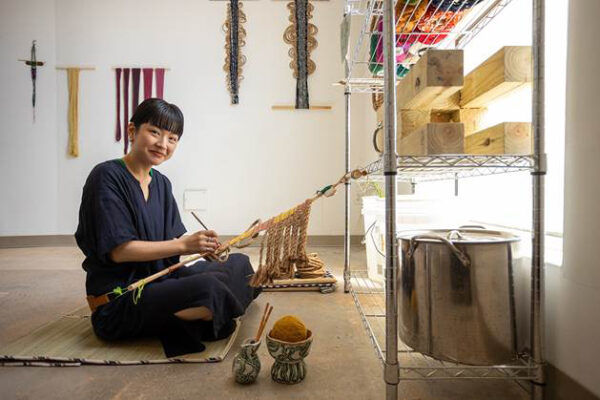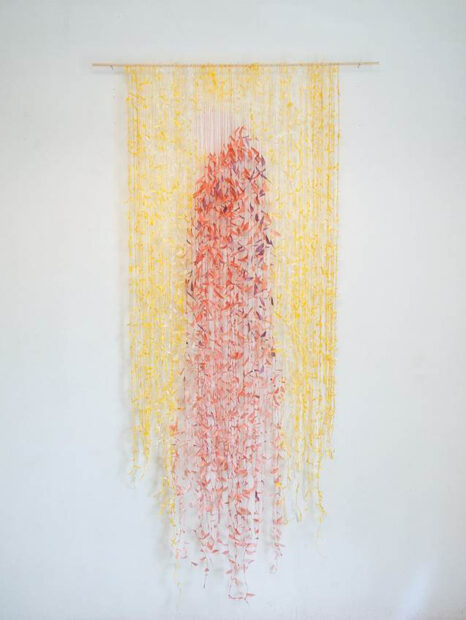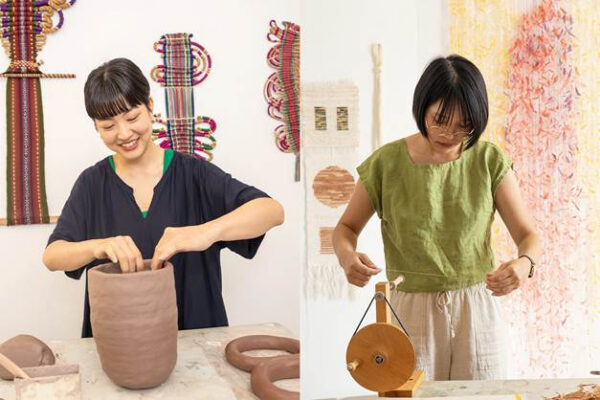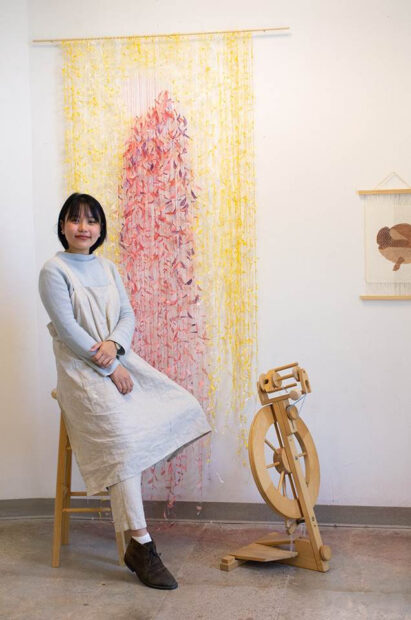
Terumi Saito, “Seeking Light,” 2023, silk, natural dyes, jute rope, wool, cotton, bamboo, wood (work in progress of the backstrap loom). Photo: Izaac Costiniano.
I recently sat down with New York-based artists Qiqing Lin and Terumi Saito to talk about all things textiles. We met at the Houston Center for Contemporary Craft (HCCC), where they were resident artists this past fall.
Saito’s signature backstrap weaving sculptures are graphic, punchy, and serpentine-like in form. Interwoven jute rope disrupts the meticulously ordered patterning, resulting in bursts of sculptural dimension. Lin specializes in large-scale tapestries composed of hand-spun paper yarn. Intricate and airy, with an incredible sense of movement, Lin’s tapestry serve as storytelling vessels to narrate topics ranging from gender to immigration and language.
We met in Saito’s sunny studio on a busy Friday afternoon at HCCC. Surrounded by wall-suspended weavings, drying clay vessels, and the faint scent of natural dye baths, we all felt right at home. Our conversation traversed themes of memory, labor, craft, and tradition. We discussed at-length their shared love of weaving, how politics, feminism, and cultural preservation figure into their practices, and the work that resulted from their residencies in Houston. Additionally, Saito and Lin provided thoughtful reflections on the realities of navigating life and artmaking in the United States as international artists.
May Howard (MH):You both came to textiles from different industries. Terumi, you have a background in graphic design, and Qiqing, you were working as a journalist in politics. What initially attracted you both to textiles?
Terumi Saito (TS): Long story short, I initially came to the U.S. for grad school for graphic design.
MH: Oh, at Parsons?
TS: Actually, Cranbrook. I got into the 2D department there. I was so excited, but I had a problem with my English test score, so I couldn’t start the program that year in September. I decided to work and prepare to apply for the next year. I had more time to think about what I really wanted to do. I was questioning if I wanted to be a graphic designer and work in a more commercial industry. I started to discover fiber art at the Museum of Art and Design. I also went to see RISD’s textile program. Because I didn’t have a background in fibers and textiles, I decided to apply for a post-bacc program at the School of the Art Institute of Chicago. I actually didn’t get into the post-bacc, but I got into the Parsons MFA Textiles program. I thought, “Oh lucky! Why not go straight for the Master’s?” So that’s how I changed fields. But I actually did my very first weaving in New York.
Qiqing Lin (QL): Where?
TS: At the Textile Art Center. I took Weaving 101 there.
QL: I think this is worth mentioning. Terumi got into the Parsons MFA Textiles Program during its first year.
MH: Right, so you were the guinea pigs! But it had to have been exciting?
TS: There was excitement. We were the inaugural cohort. But because of Covid we didn’t have a commencement. Yeah, that was a disappointment…
MH: What about you, Qiqing?
QL: I did an undergrad degree in journalism from 2010-2014. I worked as a journalist until 2021. When I was working, I always thought about doing something else. It was getting harder and harder to be a journalist in China. The last straw was, I think, in the spring of 2020, the relationship between China and the United States was really bad. There was a visa issue for foreign journalists in both countries. For example, at the time, there were new policies saying that if you were a Chinese journalist based in the U.S., you needed to renew your visa every three months. And that caused a lot of anxiety. To retaliate, the Chinese government, suddenly, late at night, published on China’s Ministry of Foreign Affairs website, affecting five American media outlets. American journalists working for the New York Times, the Wall Street Journal and the Washington Post were expelled. Some reporters working in the Chinese office who had been there for many years had to leave the country within two weeks. At the time, I was working in the Shanghai office. And if a correspondent left, as a Chinese national, I couldn’t go on reporting trips by myself. We thought, how was the office going to operate? There was a huge question mark.
At the time, I was doing lots of research trying to figure out what else to do. I wanted to do something to use my hands. I had liked making things since I was a kid, but I didn’t really have the time to do it. In China, there was a lot of pressure to study, and I went to boarding school, so I had class in the morning and evening. In doing research, I found these textile programs existed not in the fashion world, but more in the craft world like metals, jewelry, and woodworking. I had a reporting trip in 2019, and it was a big project. I stayed in New York for two months. I didn’t know anybody there. I was trying to look for something to do and I saw a program for weaving. I found one called Loop of the Loom. It’s a Japanese weaving studio in New York. I think a lot of people start there.

Terumi Saito in her studio. Photo: Katy Anderson, courtesy the Houston Center for Contemporary Craft
MH: Could you both speak to your experiences of learning weaving techniques and processes, both within the academic studio environment and through intensive master-student training?
TS: When I started my MFA, I was excited to try this new medium as a tool to convey my message. But initially, I was doing more knotting, more sculpture…I wasn’t weaving in my first semester. I was discovering what I could do as a textile maker, but I didn’t have the skills. I was feeling left behind from the people that already had an undergraduate degree and four years of knowledge. That feeling of discovery…or…not sadness, but wondering…
MH: Uncertainty?
TS: Yes, uncertainty pushed me a lot. After the first semester, I was doing more installation and performance pieces. Some of the professors were pushing me to do more performance. I enjoyed it, but I don’t think I could sustain as a performer.
QL: Were you the person doing the performance?
TS: Yeah, I was doing the performance. I enjoyed pushing my boundaries or comfort zone. After my first year I applied for a residency in Peru. I was so lucky to go there during summer break. I fell in love with the technique during the trip. It is labor intensive and difficult, but it gave me energy and excitement. It pushed me to want to learn more. The special thing I’ve been telling people about the backstrap is that my body becomes a part of the loom. This is the aspect of my performance. The full-body engagement part could be a performance.
MH: What was the residency like?
TS: I studied with the Master-Weaver in Peru during the residency. Her name is Maria. She taught us a lot. The Arquetopia Foundation didn’t let us take pictures of her.
There was one supporting staffer during that residency. It was just one house in a place called Urubamba, Peru. It’s close to Machu Picchu. You stay, work, live, and sleep there. The weaving teacher comes two days a week. The other days we would just keep weaving. I brought back two pieces with me. That was around the time that I started weaving with rope.
QL: Did you finish the pieces on site?
TS: No, no. It was only one month. There was another artist in the residency from Canada. We worked hard but it was impossible to finish. It takes a long time. You reform the beaters. Just putting the one weft takes a long time. The Masters, they have the chart in their head. There’s no weaving instruction. We had to take notes. I was following my hand-written chart when I came back. But the Master Weavers have the charts in their heads. They are so fast.
Also, in Guatemala, I felt a closer connection to the weavers. I spent more time actually with them. In Peru, it was two days a week where the Master Weaver was coming in. But in Guatemala I was going almost every day. I went to their house, but the class also took place at a community park area in a city called Antigua.
QL: Do you know how they feel about other local people learning, or do you think they have anxieties that no one is learning these techniques?
TS: Oh, yeah. In Guatemala, they are trying to pass down weaving, but because of modernization the young people want to do something else. They used to weave from a very young age. But it’s a struggle to pass down and keep traditions. It’s the same in Japan. Weaving companies are closing down because there’s no next generation keeping the weaving there.
There really is a world-wide level of this issue. We don’t have people to preserve it. It’s also a difficult topic…to make people interested in. That’s what I’m also trying to approach. That you can make this kind of work with a backstrap. Some people know of the backstrap, but a lot of people don’t know about the weaving. I always start showing the book. Like, “Hi, do you know about backstrap weaving?” “No, what is it?”
QL: It is very different from the loom weaving, for example. It’s like another craft.
TS: Especially in the U.S. And also in Japan, too. When you think about handweaving, people think of the floor loom.
QL: I feel like I’m still pretty new to weaving. I learned weaving within the last two years in school. When I was in China, even though weaving has a long tradition, I never saw anyone weaving in actual life. People in certain parts of China, especially those in the ethnic minority groups, still do the traditional weaving. I think the problem is similar in South America. The older generation still knows how, but the younger generation goes to the city for work. There are very few resources to record their techniques. There are a few books, but not that many. I think there is only one weaving studio that’s open to the public, which was set up a few years ago. That’s why I think it’s special in New York, because they have places that if you are interested in weaving, then you can try a class to see.
Before I came to New York, I did a five-day workshop in the Southern part of China with the Bouyei ethnic minority group; this group still does indigo dyeing and weaving on their big looms. It’s a project, I think, partly sponsored by the local government to preserve the techniques and culture. There are two aunties in their fifties teaching the technique…the tie-dyeing, sewing, indigo dyeing. So, I think it’s on the rise, there is more attention. I learned how to weave at Parsons. It’s a program that is open to people from different backgrounds. I actually learned a lot from another textile artist, Samantha Bittman. She’s a very technical weaver. She doesn’t talk a lot about concept. It’s all about technique. She showed me how to work and live as a professional artist. That was a completely new thing to me.
MH: When did you start developing your own vocabulary? Your own way of weaving with paper?
QL: It was the result of trying so many things. It was good to have the time to try. For a whole semester I was trying different weird materials.
MH: And that just came from you wanting to find something different?
QL: Yeah, I came from a non-textile background and the MFA program encouraged us to be more experimental. The idea was to give structure to weaving. I was looking into ways to build a weave structure that could go with the shape that I wanted. I tried everything! I researched spinning paper, which was a whole different craft. It’s a very versatile material. I can play with the structure and source paper from different places. There’s a lot of possibilities and a cultural meaning that come from what kind of paper I am using. If there’s content on it, then I can make it more meaningful. This is a material I want to work with for a while. There are still lots of new things to try during the residency here.
MH: I wanted to ask you both about your relationship to tradition. And that can be traditions of weaving and textiles, or other sorts of cultural traditions. Do you have any thoughts about tradition within a broad sense? How does tradition figure into your practice?
QL: I feel like for weaving, that’s always a question and you just have to think about it all the time.
MH: I see even in your studio, Terumi, you have traditional source material. So, you are inspired by…
TS: Yes…I grew up in a suburb with my family. When I was a child I really didn’t pay attention to cultural traditions. I didn’t grow up in a big city like Tokyo. I grew up with my grandparents. I was living with precious sculptures and traditions. I didn’t realize as a child that I had a precious experience. I feel like I also want to preserve these in the future. Maybe those feelings are connected to my textile practice. I was naturally interested in traditional techniques. Because I’m interested in backstrap, a very old technique in Japan, I’m also interested in ceramic history in Japan, from the Jōmon period. Jōmon literally means rope pattern. This period was named after these ceramics. People were using rope to make the pattern.
QL: I have a complicated feeling toward tradition, especially in China. There are of course thousands of years of history; it is very rich. But when you think of tradition, it’s often associated with some not so very good things. For example, like when I work with paper, it’s usually related to calligraphy and scroll painting. Usually people who do that are older, middle-aged men. Now, it’s not so common to see calligraphy work anymore. But you see it is in the bosses or higher rank officials’ offices. It’s very male; all about power. Usually these people don’t have a deep understanding of art and culture. It’s because of these associations that I used to avoid reading things about traditional culture. Because it’s so much about power and men and oppression. I didn’t know if I wanted to go into that.
I grew up in Southern China in a very boring city. It’s not like in a big city where you have an urban life, and it’s not in a village where you still have scenery. It’s sort of stuck in the middle. My education, and especially working as a journalist, trained me to go outside to see more of the world, to meet more people. It was never there for me, the tradition. It’s not something, like a mountain, I look up to. It was just far away.

Lin Qiqing, “Phoenix,” 2023, 36 x 92 in. hand-spun Chinese mulberry paper, dyed with sappanwood and gardenia. Photo: Lin Qiqing
MH: And, not that interesting to you?
QL: I would say that now I’m getting more interested in tradition because of weaving. Because of weaving, indeed, I read about the history of the craft, the knowledge that passes down from generation to generation. Weaving pushed me to go into the tradition part more.
MH: Was there a particular innovation or breakthrough that you both had during your residencies here?
TS: I’m happy I had the time and access to the kiln here, because I really wanted to work on this new project of a three-dimensional piece with my textiles and creating a body with ceramics. I’m currently making my woven pieces; I’m dying some.
MH: Ah, so those will be woven through the hoops on your ceramic vessels?
TS: Yeah. Hopefully. If all goes according to plan.
MH: What about you, Qiqing?
QL: My goal coming here was to have a collection of paper yarn samples. I tried different thicknesses and types of mulberry paper to make it into yarn. I did some natural dyeing on them. I later discovered two things that were new to me. One is the spinning technique. Usually paper is spun into a continuous thread, which is what I did in the past in my tapestries. For example, I spun book pages into a continuous thread and then wove it as a tapestry. And you have to look close to see the text. I like the texture even though you can tell from far away it’s not cotton; it has a stiffness. I tried a different spinning technique to add things into it. Even though the spinning wheel is not designed for that purpose.
MH: What’s next for you both? You’re both based in New York, right? Are you going back there?
TS: I am going back to work [laughing].

Terumi Saito (left) and Lin Qiqing (right) in their studios at the Houston Center for Contemporary Craft. Photo: Katy Anderson, courtesy the Houston Center for Contemporary Craft.
MH: You work in a gallery in the city, right? What is it called?
TS: Ippodo Gallery. But this experience really pushed me and inspired me to keep making every day. I feel so good. I feel this power and energy for me to live. My resolution for next year is to try to sell more of my pieces. This journey of fiber and ceramic, I’ve been really enjoying it. So next year I’d love to keep developing my new journey.
QL: I’m still figuring out my plan. I graduated from school in May. So, the next thing for me is to get my visa done, to get a lawyer and prepare the materials. It’s the big question for international artists. I’ll apply for the visa in the spring, and hopefully get it in the summer to stay in the U.S. for the next three years. It’s a good experience to do this residency right after graduation. To walk to the studio every day and work and go back home. I think I like it, I want to keep doing it; I want to make it work. The question now is to figure out how to make it work.
TS: I think also, the U.S. has more grants for funding fellowships and residencies. It’s not supported like this in Japan. It’s good, I’m fortunate that I have the opportunity to try to work.
QL: It’s hard, but it’s still doable.
MH: It’s good to have peers who have gone through similar things. I hope they can be supportive, but I know it’s a very tedious and difficult process. I wish you both luck!
This interview has been lightly edited for length and clarity.




